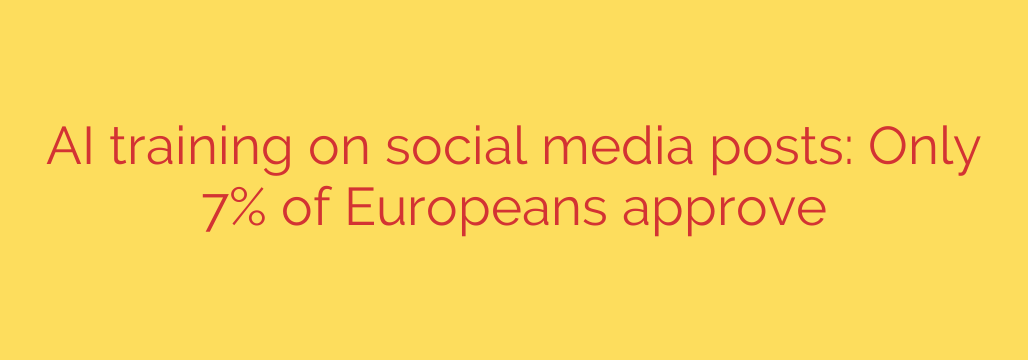
The Great Data Debate: Should AI Be Trained on Your Social Media Posts?
Have you ever wondered what happens to your old tweets, public photos, or forum comments? For years, this content has existed as part of our shared digital history. But now, it’s become a valuable resource for a new purpose: training artificial intelligence. Tech companies are scraping vast amounts of publicly available data to teach their AI models how to write, reason, and create.
The question is: how do people feel about their public words and images being used in this way? A recent look at public opinion reveals a stark and telling answer. When it comes to using public social media posts for AI training, a staggering majority of people are not on board.
A Crisis of Public Trust
The numbers paint a clear picture of public unease. An in-depth survey reveals that only 7% of Europeans approve of their public social media data being used to train AI systems. This isn’t just slight hesitation; it’s a landslide of disapproval that signals a major disconnect between the tech industry’s practices and public expectations.
The vast majority of individuals believe that using their data without direct permission is a step too far. This sentiment cuts across different demographics, indicating a widespread concern about data privacy and the unchecked harvesting of personal information. The core issue is a feeling of lost control—that the content they shared for one purpose is now being repurposed for commercial gain without their knowledge or consent.
The Root of the Mistrust: Consent, Control, and Compensation
Why is public opposition so strong? The resistance isn’t just about privacy in general; it’s rooted in several specific concerns that the tech industry has yet to adequately address.
The Lack of Explicit Consent: Most users never agreed to have their digital footprint used to build AI products. When people posted online a decade ago—or even last week—they did so to communicate with friends, share ideas, or participate in a community. They did not sign up to be unpaid contributors to the development of multi-billion dollar AI models. This retroactive use of data feels like a violation of the original, unspoken agreement between a user and a platform.
The “Public” vs. “Published” Debate: Tech companies often argue that if data is publicly available, it’s fair game for scraping. However, the public sees a critical distinction. Publishing something for human eyes on a specific platform is fundamentally different from consenting to its use in a massive, downloadable dataset for machine learning. The context is lost, and the potential for misuse grows exponentially.
No Benefit for the User: People are providing the raw material—their thoughts, creativity, and experiences—that makes modern AI possible. Yet, they receive no direct compensation or recognition for this contribution. The value generated from their data flows directly to large corporations, creating a power imbalance that fuels public resentment.
The Argument for Data: Fueling AI Innovation
From the perspective of AI developers, this data is not just useful; it’s essential. Training a sophisticated large language model (LLM) requires an immense and diverse dataset to help it understand language, context, and human nuance. The internet, particularly social media, offers a treasure trove of natural conversation and information that is unparalleled in scale.
Developers argue that this process is necessary to push the boundaries of technology and create the powerful tools that are already changing how we work and create. However, the growing public backlash suggests that the “move fast and break things” approach may be reaching its ethical limit.
How to Protect Your Digital Footprint: Actionable Security Tips
While systemic change is needed, you can take steps to better control your data and limit your exposure to automated scraping.
Audit Your Privacy Settings: The most important step is to review the privacy settings on all your social media accounts. Where possible, set your profile and posts to private or “friends only.” This is the single most effective barrier against public data scraping.
Think Before You Post: Treat everything you post online as permanent and public, even in seemingly private groups. Avoid sharing highly personal information, such as your full address, phone number, or sensitive personal details that could be exploited.
Perform a Digital Cleanup: Periodically review and delete old posts, photos, or accounts you no longer use. Reducing your public digital footprint minimizes the amount of data available to be scraped.
Read the Terms of Service: While dense, the terms of service for new apps and platforms often contain clauses about how your data will be used. Look for language related to content ownership, third-party sharing, and AI training.
The Path Forward: Rebuilding Trust in the Age of AI
The current situation is unsustainable. The deep-seated public mistrust around data scraping is a clear signal that the status quo must change. For AI to evolve responsibly, the industry must move toward a model built on transparency, ethics, and explicit user consent.
This means creating clear policies that give users real control over their data, exploring methods for fair compensation, and developing ethical guidelines for data collection. Without rebuilding this broken trust, the incredible potential of artificial intelligence will always be shadowed by the public’s legitimate fear that their privacy is the price of progress.
Source: https://go.theregister.com/feed/www.theregister.com/2025/08/07/meta_training_ai_on_social/








